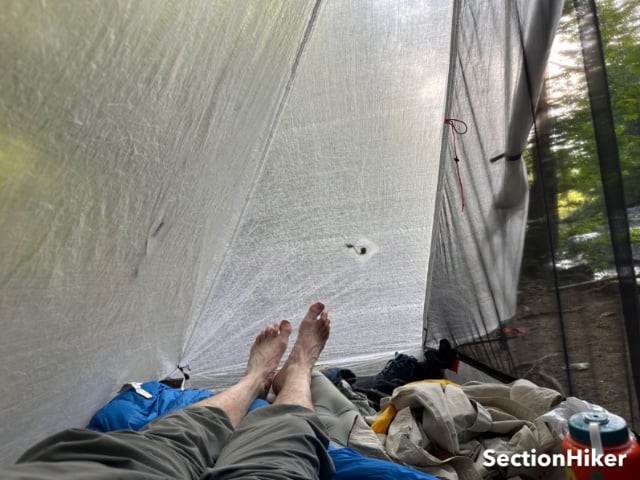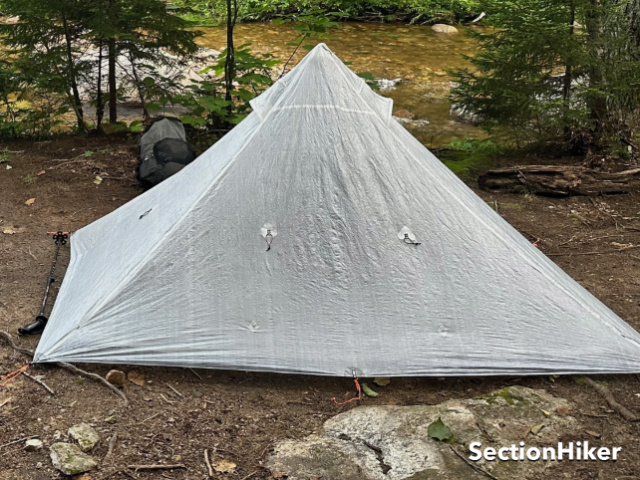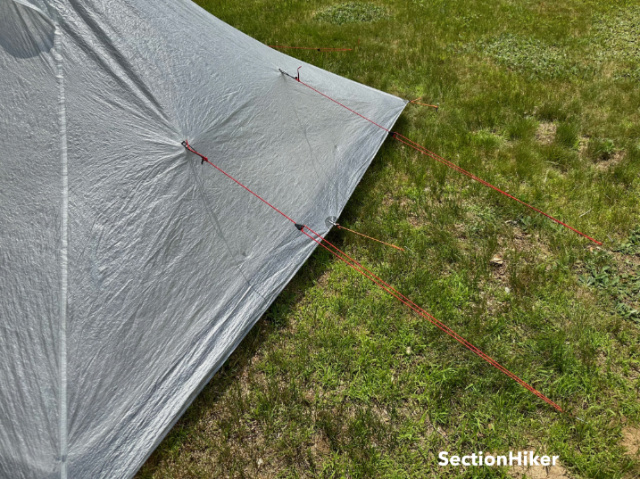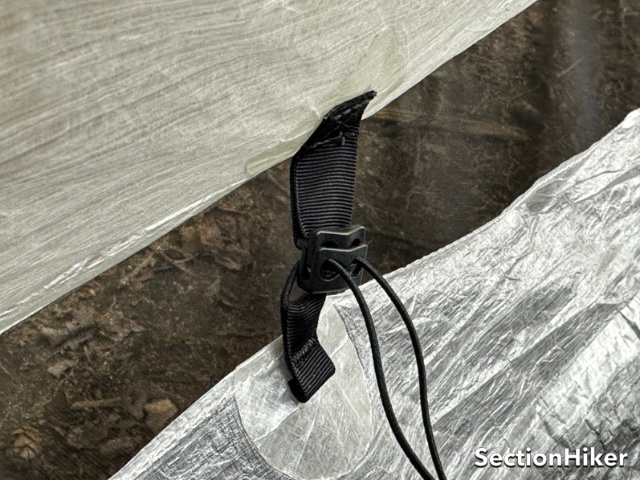The Hyperlite Mountain Gear Mid-1 Tent is an ultralight single-wall Dyneema DCF tent that weighs 16.8 oz. It has a pyramid shape with steep walls and a very long bathtub floor that makes it ideal for tall backpackers or those desiring more interior space. The floor is floating and attached to the tent walls with noseeum mesh to enhance airflow. The tent requires 1 trekking pole to pitch and comes with a carbon fiber pole jack to increase its length since the tent’s dimensions are so oversized. The Mid 1 Tent is a comfortable though minimalist shelter that’s nice for camping in protected tent sites, with plenty of external guy-out points to anchor it in windier conditions.
RELATED: 10 Best Ultralight Backpacking Tents
Specs at a Glance
- Capacity: 1 Person
- Type: Single-Wall Trekking Pole Tent
- Weight: 1.05 lbs | 16.80 oz. | 476.27 g
- Minimum Number of Stakes to Pitch: 6 | Recommended: 9-11
- Material: Dyneema DCF, Noseeum Mesh
- Area: 21 Sq. Ft
- Width: Exterior: 54″ or 137cm | Interior: 32″ or 81 cm
- Length: Exterior: 107″ or 271cm | Interior: 96″ or 244 cm
- Height: 54″
- Packed Dimensions: 8.5″ x 5.5″ x 5.5″
The Hyperlite Mountain Gear Mid 1 Tent is a single-wall pyramid tent, meaning that it has a screened-off interior compartment with an attached bathtub floor that faces an interior vestibule space for gear storage. The tent is made with Dyneema DCF which is a strong, waterproof, and ultralight material that does not sag when it gets wet, unlike more traditional tents made with siliconized nylon, siliconized polyester, or nylon with a polyurethane coating. The tent’s seams are all taped and the tent is waterproof out of the box.

The Mid 1 Tent has a very long bathtub floor and steep side walls designed to provide its occupant with extra interior space. Pyramid tents and tarps, with their angled sides, normally have limited interior height at the head and foot ends or sides because their walls are so sloped, which can lead to a feeling of claustrophobia if your face is just inches from the ceiling. The Mid 1 counters this with its long bathtub floor (96″), so its occupant can sit in the middle of the floor and use the extra space at the ends for interior gear storage. For example, if you’re 6′ tall, you’d have an extra 1 foot of space above your heat and below your feet for gear storage.

The Mid 1 Tent is a single-wall tent so it sets up as a single unit with an integrated rain fly and interior floor. While this helps keep the weight down, single-wall tents are more prone to internal condensation which can make your gear and clothing wet if you come in contact with the wet tent walls. The best way to reduce or prevent internal condensation is to sleep with the doors of a single-wall tent open, so air can flow through freely. That’s not always possible however due to weather conditions.

The Mid 1 comes outfitted with precut guylines and line-loc tensioners along the base of the tent. Tent stakes are not included with the tent. We’d recommend using fairly beefy tent stakes with the Mid-1 because the tent walls have so much surface area and can they can catch a lot of wind, like a sail. The tent also comes with panel guy out points, which we recommend using to help expand the interior space of the tent, particularly if it’s windy, and help prevent internal condensation transfer.

Precut guylines and tensioners are not included for these guyout points and you’ll need to supply your own. When used, you will need an even larger space to anchor the tent since their stakes will extend well past the edges of the bottom of the tent.

The Mid 1 tent has an offset design that is wider above the sleeping area and narrower in the vestibule. The vestibule still has plenty of space for gear storage and even cooking (carefully and without an open flame) in poor weather. The vestibule doors close with a two-way waterproof zipper, which can be unzipped from the top to enhance airflow. The doors can also be rolled back independently and have magnetic tiebacks which are much easier to use than the cordlock/toggle affairs used on other tents.

The front vestibule has a two-way, waterproof zipper which is handy during setup because it lets you insert your trekking pole into the top peak without having to open up the entire front door. This is handy if it’s raining outside because it lets you keep the tent interior reasonably dry. While the tent peak is reinforced it is designed to hold your trekking pole handle. A 6″ pole jack is included with the Mid 1 to increase the length of your trekking pole to 54″: a pole jack is simply a sleeve that fits around the tip of a trekking pole to give it more length. If you lose it (it’s black), a traditional tent pole repair sleeve usually does the trick. So does stacking gear, rocks, paperback books, etc.

The peak also has two large covered vents, lined with noseeum netting inside, for additional airflow. They’re shaped like scoops with stiffeners inside to prevent them from collapsing closed.

The Mid 1 comes with a single guyline for staking out the vestibule and front of the tent. It’s located at the bottom of one of the vestibule doors but can be easily moved and clipped to the other if you only want to keep one of the doors open at night for ventilation. While that single stake provides a strong anchor point when both vestibule doors are zippered together, the Mid 1 becomes noticeably less stable when one door is open and the other closed and even more unsteady if both vestibule doors are unzipped and rolled back, opening up the entire front of the tent. To address both these cases, I recommend adding a guyline to the peak and staking it out separately, with the webbing guy-out loop supplied there.

The length you set your pole to can vary a little depending on how much ventilation you need. In good weather, it’s nice to have a few inches of space between the bottom edge of the tent and the ground to facilitate airflow. You can batten things down tighter in heavy rain and bring the edges closer to the ground.

The bathtub floor floats inside the tent – which is handy when pitching on uneven ground. It is connected to the interior walls on three sides by noseeum mesh to prevent insects and creepy crawlers from entering. You can raise the walls of the bathtub floor to be more vertical by adjusting locking cord locks around the perimeter that bring it closer to the tent’s walls. The front side of the bathtub floor is noticeably deeper than around the other three sides to prevent dust and moisture from blowing under the vestibule door and into the screened-in space.
The interior of the screened portion of the Mid 1 is pretty sparse. There is one mesh pocket position along the bathtub floor at the center of the tent below the noseeum zipper entry. However, there are no interior loops attached to the ceiling to suspend damp clothing, hang a headlamp, or hang your glasses from so they don’t accidentally get crushed on the tent floor. I’d seriously consider adding some of the stick-on loops and hooks sold by Zpacks for their Dyneema shelters for this purpose. It will increase the interior livability.

Competition
The closest competitor to the Hyperlite Mid 1 is the Zpacks Altaplex which is a 15.4 oz single wall, pyramid-shaped Dyneema DCF tent designed for taller hikers. Dimensionally, the two tents are pretty similar although the interior of the Mid 1 is a half foot longer than the Altraplex while the Altaplex bathtub floor is 4″ wider than the Mid 1’s. In addition, the Altaplex has a deeper, more structured bathtub floor and a wider door for entering the inner tent, among other differences. It is also about 10% more expensive.
Recommendation
The Hyperlite Mountain Gear Mid 1 Tent is a single-wall Dyneema DCF tent that weighs 16.8 oz. Designed for taller hikers or people wanting more interior space, it is a spacious shelter suitable for use in protected campsites as well as windy conditions when fully guyed out. When considering whether to buy the Mid 1, ask yourself whether you’ll have sufficient room to set it up on the tent sites where you plan to use it, as it has a large footprint if you use all the guy-out points. In addition, it’s important to note that most Dyneema pyramid shelters, called “Mids”, are modular tent systems with a separate pyramid-shaped tarp and optional inner tent. Single wall Mid’s, like the Mid 1 Tent are still pretty rare, but can be advantageous when space or gear weight are paramount concerns.
Disclosure: Hyperlite Mountain Gear donated a tent for review.
Compare 1 Prices
Last updated: 2023-07-07 22:09:19
SectionHiker is reader-supported. We only make money if you purchase a product through our affiliate links. Help us continue to test and write unsponsored and independent gear reviews, beginner FAQs, and free hiking guides.
